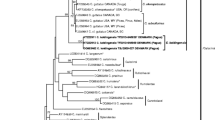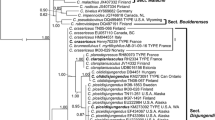Abstract
Cortinarius coalescens Kärcher & Seibt is a rare European species of the subgenus Phlegmacium, section Phlegmacioides, neglected in recent molecular studies. New primers (CortF and CortR) designed for species in the section Phlegmacioides allowed to obtain ITS rDNA sequence data from the holotype collection of C. coalescens; according to the results, this epithet has priority over C. crassorum Rob. Henry ex Rob. Henry, C. pardinus Reumaux, and C. parargutus Bidaud, Moënne-Locc. & Reumaux. Morphological and ecological observations on recent collections of C. coalescens from the Czech Republic in comparison with the co-occurring C. largus are discussed. Nomenclatural and taxonomic comments on C. tomentosus Rob. Henry, C. balteatotomentosus Rob. Henry, and C. subtomentosus Reumaux are also provided. So far, C. coalescens is known with certainty from Germany, France, and the Czech Republic, where it grows in deciduous forests on acid to neutral soils. Arsenic and its compounds were determined in C. coalescens and related species of the section Phlegmacioides: C. largus, C. pseudodaulnoyae, and C. variecolor. Total arsenic concentrations were in the range 3.6–30.2 mg kg−1 (dry matter) and arsenobetaine was the major arsenic compound.







Similar content being viewed by others
References
Baize D (1993) Soil science analyses: a guide to current use. John Wiley & Sons Ltd., Chichester
Bentley R, Chasteen TG (2002) Microbial methylation of metalloids: arsenic, antimony, and bismuth. Microbiol Mol Biol Rev 66:250–271. doi:10.1128/mmbr.66.2.250-271.2002
Bidaud A, Bellanger JM (2016) À propos de Cortinarius daulnoyae Quél. J JEC 18:13–23
Bidaud A, Moënne-Loccoz P, Reumaux P, Henry R (1995) Atlas des Cortinaires VII. Fédération Mycologique Dauphiné-Savoie, Annecy
Bidaud A, Moënne-Loccoz P, Reumaux P, Henry R (1999) Atlas des Cortinaires IX. Fédération Mycologique Dauphiné-Savoie, Annecy
Borovička J, Řanda Z, Jelínek E (2006) Antimony content of macrofungi from clean and polluted areas. Chemosphere 64:1837–1844. doi:10.1016/j.chemosphere.2006.01.060
Borovička J, Řanda Z, Jelínek E, Kotrba P, Dunn CE (2007) Hyperaccumulation of silver by Amanita strobiliformis and related species of the section Lepidella. Mycol Res 111:1339–1344. doi:10.1016/j.mycres.2007.08.015
Borovička J, Kotrba P, Gryndler M, Mihaljevič M, Řanda Z, Rohovec J, Cajthaml T, Stijve T, Dunn CE (2010) Bioaccumulation of silver in ectomycorrhizal and saprobic macrofungi from pristine and polluted areas. Sci Total Env 408:2733–2744. doi:10.1016/j.scitotenv.2010.02.031
Borovička J, Noordeloos ME, Gryndler M, Oborník M (2011) Molecular phylogeny of Psilocybe cyanescens complex in Europe, with reference to the position of the secotioid Weraroa novae-zelandiae. Mycol Prog 10:149–155. doi:10.1007/s11557-010-0684-3
Borovička J, Rockefeller A, Werner PG (2012) Psilocybe allenii—a new bluing species from the Pacific coast, USA. Czech Mycol 64:181–195
Borovička J, Bušek B, Mikšík M, Dvořák D, Jeppesen TS, Dima B, Albert L, Frøslev TG (2015a) Cortinarius prodigiosus—a new species of the subgenus Phlegmacium from Central Europe. Mycol Prog 14:29. doi:10.1007/s11557-015-1051-1
Borovička J, Oborník M, Stříbrný J, Noordeloos ME, Parra Sánchez LA, Gryndler M (2015b) Phylogenetic and chemical studies in the potential psychotropic species complex of Psilocybe atrobrunnea with taxonomic and nomenclatural notes. Persoonia 34:1–9. doi:10.3767/003158515X685283
Brandrud TE (1998) Cortinarius subgenus Phlegmacium section Phlegmacioides (= Variecolores) in Europe. Edinb J Bot 55:65–156. doi:10.1017/S0960428600004364
Cejpková J, Gryndler M, Hršelová H, Kotrba P, Řanda Z, Synková I, Borovička J (2016) Bioaccumulation of heavy metals, metalloids, and chlorine in ectomycorrhizae from smelter-polluted area. Env Poll 218:176–185. doi:10.1016/j.envpol.2016.08.009
Cullen WR (2014) Chemical mechanism of arsenic biomethylation. Chem Res Toxicol 27:457–461. doi:10.1021/tx400441h
Ertl K, Kitzer R, Goessler W (2016) Elemental composition of game meat from Austria. Food Addit Contam B 9:120–126. doi:10.1080/19393210.2016.1151464
Falandysz J, Borovička J (2013) Macro and trace mineral constituents and radionuclides in mushrooms: health benefits and risks. Appl Microbiol Biotechnol 97:477–501. doi:10.1007/s00253-012-4552-8
Falandysz J, Rizal LM (2016) Arsenic and its compounds in mushrooms: a review. J Environ Sci Health C 34:217–232. doi:10.1080/10590501.2016.1235935
Garnica S, Weiß M, Oertel B, Oberwinkler F (2003) Phylogenetic relationships of European Phlegmacium species (Cortinarius, Agaricales). Mycologia 95:1155–1170. doi:10.2307/3761917
Garnica S, Weiß M, Oertel B, Oberwinkler F (2005) A framework for a phylogenetic classification in the genus Cortinarius (Basidiomycota, Agaricales) derived from morphological and molecular data. Can J Bot 83:1457–1477. doi:10.1139/b05-107
Garnica S, Schön ME, Abarenkov K, Riess K, Liimatainen K, Niskanen T, Dima B, Soop K, Froeslev TG, Jeppesen TS, Peintner U, Brandrud TE, Saar G, Oertel B, Ammirati J (2016) Determining threshold values for barcoding fungi: lessons from Cortinarius (Basidiomycota), a highly diverse and widespread ectomycorrhizal genus. FEMS Microbiol Ecol 92:fiw045. doi:10.1093/femsec/fiw045
Gouy M, Guindon S, Gascuel O (2010) SeaView version 4: a multiplatform graphical user interface for sequence alignment and phylogenetic tree building. Mol Biol Evol 27:221–224. doi:10.1093/molbev/msp259
Hall TA (1999) BioEdit: a user-friendly biological sequence alignment editor and analysis program for Windows 95/98/NT. Nucl Acids Symp Ser 41:95–98
Henry R (1958) Suite à l’étude des Cortinaires. Bull Soc Mycol Fr 74:249–361
Henry R (1985a) Nouvelle étude de Cortinaires. Bull Soc Mycol Fr 101:1–13
Henry R (1985b) Validations—Diagnoses Latines. Doc Mycol 16:47–54
Henry R (1988) Nouvelles validations et typifications. Doc Mycol 19:63–68
Horak E (2005) Röhrlinge und Blätterpilze in Europa. Elsevier, München
IUSS Working Group WRB (2015) World Reference Base for Soil Resources 2014, update 2015. International soil classification system for naming soils and creating legends for soil maps. World Soil Resources Reports No. 106, FAO, Rome 192 pp
Jahn R, Blume HP, Asio VB, Spaargaren O, Schad P (2006) Guidelines for soil description, 4th edn. FAO, Rome
Kabata-Pendias A (2011) Trace elements in soils and plants, 4th edn. CRC Press, Boca Raton
Kalač P (2010) Trace element contents in European species of wild growing edible mushrooms: a review for the period 2000–2009. Food Chem 122:2–15. doi:10.1016/j.foodchem.2010.02.045
Kalač P, Svoboda L (2000) A review of trace element concentrations in edible mushrooms. Food Chem 69:273–281. doi:10.1016/S0308-8146(99)00264-2
Kärcher R, Seibt D (1988) Beitrag zur Kenntnis der Pilzflora des Rhein-Main-Gebietes. Teil 1 – Pilzgesellschaften im Kronberger Edelkastanienhain – Cortinarius subgenus Phlegmacium und Myxacium. Z Mykol 54:77–92
Kärcher R, Seibt D (1991) Beitrag zur Kenntnis der Pilzflora des Rhein-Main-Gebietes. Teil 3 – Neues über Cortinarius (Phl.) coalescens Kärcher & Seibt (1988) sowie Diskussionen über nahestahende Taxa aus Laubwaldgesellschaften. Z Mykol 57:249–252
Katoh K, Toh H (2008) Recent developments in the MAFFT multiple sequence alignment program. Brief Bioinform 9:286–298. doi:10.1093/bib/bbn013
Katoh K, Kuma KI, Toh H, Miyata T (2005) MAFFT version 5: Improvement in accuracy of multiple sequence alignment. Nucleic Acids Res 33:511–518. doi:10.1093/nar/gki198
Knudsen H, Vesterholt J (eds) (2012) Funga Nordica, 2nd edn. Nordsvamp, Copenhagen
Kubrová J, Žigová A, Řanda Z, Rohovec J, Gryndler M, Krausová I, Dunn CE, Kotrba P, Borovička J (2014) On the possible role of macrofungi in the biogeochemical fate of uranium in polluted forest soils. J Haz Mat 280:79–88. doi:10.1016/j.jhazmat.2014.07.050
Kühner R, Romagnesi H (1953) Flore Analytique des Champignons Supérieurs (agarics, bolets, chanterelles). Masson, Paris
Liimatainen K, Niskanen T, Dima B, Kytövuori I, Ammirati JF, Frøslev TG (2014) The largest type study of Agaricales species to date: Bringing identification and nomenclature of Phlegmacium (Cortinarius) into the DNA era. Persoonia 33:98–140. doi:10.3767/003158514X684681
Moser MM (1961) Die Gattung Phlegmacium. Julius Klinkhardt, Bad Heilbrunn Obb
Nearing MM, Koch I, Reimer KJ (2014) Arsenic speciation in edible mushrooms. Environ Sci Technol 48:14203–14210. doi:10.1021/es5038468
Nearing MM, Koch I, Reimer KJ (2015) Uptake and transformation of arsenic during the vegetative life stage of terrestrial fungi. Env Poll 197:108–115. doi:10.1016/j.envpol.2014.12.006
Nearing MM, Koch I, Reimer KJ (2016) Uptake and transformation of arsenic during the reproductive life stage of Agaricus bisporus and Agaricus campestris. J Environ Sci 49:140–149. doi:10.1016/j.jes.2016.06.021
Reumaux P (1988) En marge de l’Atlas des Cortinaires (validation d’espèces nouvelles). Bull Trim Féd Mycol Dauph-Sav 28:25–30
Ronquist F, Huelsenbeck JP (2003) MrBayes 3: Bayesian phylogenetic inference under mixed models. Bioinformatics 19:1572–1574. doi:10.1093/bioinformatics/btg180
Scheer J, Findenig S, Goessler W, Francesconi KA, Howard B, Umans JG, Pollak J, Tellez-Plaza M, Silbergeld EK, Guallar E, Navas-Acien A (2012) Arsenic species and selected metals in human urine: validation of HPLC/ICPMS and ICPMS procedures for a long-term population-based epidemiological study. Anal Methods 4:406–413. doi:10.1039/C2AY05638K
Shao D, Tang S, Healy RA, Imerman PM, Schrunk DE, Rumbeiha WK (2016) A novel orellanine containing mushroom Cortinarius armillatus. Toxicon 114:65–74. doi:10.1016/j.toxicon.2016.02.010
Silvestro D, Michalak I (2012) raxmlGUI: a graphical front-end for RAxML. Org Divers Evol 12:335–337. doi:10.1007/s13127-011-0056-0
Šlejkovec Z, Byrne AR, Stijve T, Goessler W, Irgolic KJ (1997) Arsenic compounds in higher fungi. Appl Organomet Chem 11:673–682. doi:10.1002/(SICI)1099-0739(199708)11:8<673::AID-AOC620>3.0.CO;2-1
Stamatakis A (2014) RAxML version 8: a tool for phylogenetic analysis and post-analysis of large phylogenies. Bioinformatics 30:1312–1313. doi:10.1093/bioinformatics/btu033
Tamura K, Stecher G, Peterson D, Filipski A, Kumar S (2013) MEGA6: molecular evolutionary genetics analysis version 6.0. Mol Biol Evol 30:2725–2729. doi:10.1093/molbev/mst197
Thiers B (2017) [continuously updated] Index Herbariorum: A global directory of public herbaria and associated staff. New York Botanical Garden’s Virtual Herbarium. http://sweetgum.nybg.org/ih/
van Reeuwijk LP (2002) Procedures for soil analysis. Technical paper 9. International Soil Reference and Information Centre (ISRIC), Wageningen
Wenzel WW, Kirchbaumer N, Prohaska T, Stingeder G, Lombi E, Adriano DC (2001) Arsenic fractionation in soils using an improved sequential extraction procedure. Anal Chim Acta 436:309–323. doi:10.1016/S0003-2670(01)00924-2
Acknowledgements
We thank Luis Alberto Parra-Sánchez for the invaluable comments on nomenclature, Jan Běťák for donating his collection of C. pseudodaulnoyae, and Tereza Tejklová for the kind assistance with the literature. Furthermore, we thank the curators of herbaria FR, G, O, PC, PRM, and TUB for providing their collections for microscopic and molecular study. André Bidaud and Patrick Reumaux are acknowledged for sending us the holotype of C. subtomentosus. This research was supported by the joint project GAČR GF16-34839 L (Czech Science Foundation) – FWF I 2352-B21 (Austrian Science Fund). The visit of Bálint Dima in PC was financially supported by SYNTHESYS, the European Union-funded Integrated Activities grant (application FR-TAF-4253). Institutional support for the institutes of the Czech Academy of Sciences was provided by the Long-term Development Projects RVO61388971, RVO67985831, and RVO61389005. INAA irradiations were carried out at the infrastructure of the NPI CAS Řež supported through the projects LM2011019 and LM2015074 (Ministry of Education, Youth and Sports of the Czech Republic).
Author information
Authors and Affiliations
Corresponding author
Additional information
Section Editor: Zhu-Liang Yang
Electronic supplementary material
Below is the link to the electronic supplementary material.
ESM 1
(DOCX 19 kb)
Rights and permissions
About this article
Cite this article
Borovička, J., Braeuer, S., Žigová, A. et al. Resurrection of Cortinarius coalescens: taxonomy, chemistry, and ecology. Mycol Progress 16, 927–939 (2017). https://doi.org/10.1007/s11557-017-1331-z
Received:
Revised:
Accepted:
Published:
Issue Date:
DOI: https://doi.org/10.1007/s11557-017-1331-z




